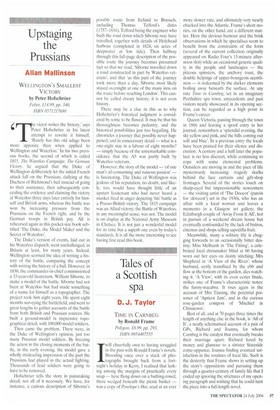Upstaging the Prussians
Allan Mallinson
WELLINGTON'S SMALLEST VICTORY by Peter Hofschreer Faber, 0 4.99, pp. 340, ISBN 0571217680 4 T' e victor writes the history,' says i eter Hofschroer n his latest T' to rewrite it himself.
Rarely has this old adage been more apposite than when applied to Wellington and Waterloo.' In his two previous books, the second of which is called 1815, The Waterloo Campaign: The German Victory, he argued that the Duke of Wellington deliberately let the initial French attack fall on the Prussians, dallying at the Duchess of Richmond's ball instead of going to their assistance, then subsequently concealing the evidence and claiming the victory at Waterloo three days later entirely for himself and British arms, whereas the battle was won by increasing pressure from the Prussians on the French right, and by the German troops in British pay. All is rehearsed again in this pocket-size book subtitled 'The Duke. the Model Maker and the Secret of Waterloo'.
The Duke's version of events, laid out in his Waterloo dispatch, went unchallenged, in Britain at least, for many years. Indeed, Wellington scorned the idea of writing a history of the battle, comparing the concept with writing the history of a ball. However, in 1830, the commander-in-chief commissioned a 33-year-old lieutenant, William Siborne, to make a model of the battle. Siborne had not been at Waterloo but had made something of a name for himself as a topographer. The project took him eight years. He spent eight months surveying the battlefield, and went to great lengths to gather accounts of the battle from both British and Prussian sources. He built a ground-model in impressive topographical detail, with 100,000 model soldiers.
Then came the problem. There were, in the Duke of Wellington's opinion, just too many Prussian model soldiers. By freezing the action in the closing moments of the battle, in the early evening, the model gave a wholly misleading impression of the part the Prussians had played in the actual fighting. Thousands of lead soldiers were going to have to be removed.
Hofschrber tells the story in painstaking detail, not all of it necessary. We have, for instance, a curious description of Sibome's possible route from Ireland to Brussels, including Thomas Telford's dates (1757-1834). Telford being the engineer who built the road down which Siborne may have travelled, together with details of Holyhead harbour (completed in 1824, six acres of deepwater at low tide). Then halfway through this full-page description of the possible route the journey becomes presumed fact so that we read, `Siborne travelled down a road constructed in part by Waterloo veterans', and that 'as this part of the journey took more than a day, Siborne most likely stayed overnight at one of the many inns on the route before reaching London'. This cannot be called dreary history; it is not even history.
There may be a clue in this as to why Hofschrber's historical judgment is considered by some to be flawed. It may be that his thoroughness becomes pedantry. and the historical possibilities just too beguiling. He chronicles a journey that possibly never happened, and in unnecessary detail —what is a one-night stay in a labour of eight months? — simply because of the unremarkable coincidence that the A5 was partly built by Waterloo veterans.
However, the story of the model — 'of one man's all-consuming and ruinous passion' — is fascinating. The Duke of Wellington was jealous of his reputation, no doubt, and likely. too, would have thought little of an upstart lieutenant who had never heard a musket fired in anger depicting 'his' battle as a Prusso-British victory. The 1815 campaign was an Allied victory; the Battle of Waterloo, in any meaningful sense, was not. The model is on display at the National Army Museum in Chelsea. It is not just a wonderful model for its time but a superb one even by today's standards. It is all the more interesting to see having first read this book.


























































 Previous page
Previous page